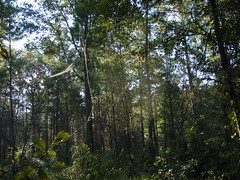Yes, Brown Dog and Yellow Dog found another hog-nosed snake. Hiding:
John S. Quarterman, Gretchen Quarterman, Brown Dog, Yellow Dog, Lowndes County, Georgia, 10 March 2012.
Pictures by John S. Quarterman for Okra Paradise Farms.
Boxed:
Yes, Brown Dog and Yellow Dog found another hog-nosed snake. Hiding:
Boxed:
Yellow Dog and Brown Dog pointing:
Pictures by John S. Quarterman for Okra Paradise Farms.
Can you see it there, between the wiregrass and the oak log?
About Longleaf (Pinus palustris), wiregrass (Aristida stricta), and gopher tortoise (Gopherus polyphemus) by the Longleaf Alliance:
We believe that longleaf in any form is better than a cotton field; that longleaf and native ground cover (like wiregrass) is better than longleaf alone; that longleaf, wiregrass, and gopher tortoises are better than longleaf and wiregrass alone.
Picture of Pinus palustris and Aristida stricta by John S. Quarterman, Lowndes County, Georgia, 19 February 2011.
-jsq
Quail and gopher tortoises eat it. Many birds, reptiles, and small animals use it for covers. For centuries settlers grazed cattle on it. Burn it in May for it to make seed in October. It thrives in fire forests with longleaf pine.
Map of Wiregrass Georgia:
The region also extends into south Alabama and north Florida. There’s so little native wiregrass left that the only place t hat seems to have a map of the region is the Huxford Genealogical Society in Homerville, right in the center of Wiregrass Georgia.
Wiregrass with small dogs for scale:
This wiregrass is native; it’s been growing here for 15,000 y ears since the last Ice Age.
Pictures by John S. Quarterman, Lowndes County, Georgia, 19 Feb 2011.
-jsq
 Looking for Longleaf: The Fall and Rise of an American Forest,
by Lawrence S. Earley
Looking for Longleaf: The Fall and Rise of an American Forest,
by Lawrence S. Earley
The tallest and strongest of pine trees, longleaf made great sailing ship masts , tar for caulking ships, and of course saw timber. How the early settlers cut down trees for houses and to clear land to farm. Their hogs and cows running loose in the woods ate the young longleaf, suppressing new trees for a hundred years. Then professional forestry took over, trying to suppress the fire that destroyed northern white pine forests, yet which preserves southern longleaf pine forests. The sad story of turpentine: we knew better, but we did it anyway.
The peculiar life cycle of a tree that starts out looking like a clump of grass, and can stay that way for decades, yet promotes and survives fire and can grow more than 100 feet tall and live for centuries. The thousands of species of plants, animals, and fungi the forest protects, many of them, like wiregrass, also adapted to fire.
How tuberculosis and quail led to new understandings of longleaf and fire, and the people who discovered those things. We do know how to grow these trees now, and lots of people are doing it: for jobs, for sawtimber, for the beauty of the forest.
 The state of Georgia already finances a
Conservation Reserve Program (CRP)
to plant longleaf pines with
associated native ground cover (partridge pea that the quail like,
and bunch grasses such as wiregrass that help fuel periodic fires).
The state of Georgia already finances a
Conservation Reserve Program (CRP)
to plant longleaf pines with
associated native ground cover (partridge pea that the quail like,
and bunch grasses such as wiregrass that help fuel periodic fires).
However, CRP payments typically only last 10 years and not more than 15 years, and such trees usually eventually get cut for sawtimber or pulpwood. Now that’s better than cotton: much less pollution involved and far more carbon sequestered.
But even better would be to treat such replanting as real reforestration and sell carbon sequestration rights for such forests. Like what is being planned in Florida: Continue reading